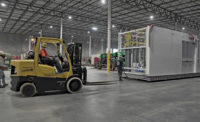Labor
2022 1Q Cost Report: Executive Pay Expected to Rise as Firms Look to Future

With first-quarter construction starts trending above 2021 activity, the industry’s need to attract and retain talent is on the rise as well. At the executive level, companies are not only eyeing current needs, but also future succession plans, prompting firms to offer compensation increases that have not been seen in more than a decade.
In 2021, executives saw a 4.3% increase in base salary over 2020, according to industry compensation research firm PAS. That bump followed a slight pullback in 2020—attributed to pandemic shutdowns—when increases averaged 3.8%. Firms that responded to the PAS 2022 Executive Compensation Survey for Contractors estimated that 2022 salary increases will hold at 4.3% this year. However, Jeff Robinson, president of PAS, says that he sees firms already pushing above that. “I’m comfortable saying that we could see 4.8% this year and I wouldn’t be surprised if it hits 5%.”
Related link: ENR 2022 1Q Cost Report PDF
Subscription Required
If that forecast holds, salary increases would reach 5% for the first time in 15 years, based on PAS data. Robinson notes that staff and executive pay increases follow steady rises in rates for hourly workers, as the industry grapples with labor shortages. “Once you raise the craft level and the staff level, you have to give raises to the people above them,” he says.
After years of making up a large percentage of total compensation, bonuses dipped in 2022, according to PAS data. On average, bonuses as a percentage of base pay fell 9% this year compared to last year. Bonuses for presidents came in at 80% of base pay—down 12% from last year. Vice presidents of operations should see bonuses at 46% of base pay this year—down 11% from 2021. Only vice presidents of business development will see bonuses rising this year, by 8% on average. Robinson says that after big bonuses in recent years, they have settled back to previous levels. PAS data shows that current averages for bonuses as a percentage of base pay are similar to those in 2017.
Alan MacNair, president of MacNair Retained Search, says that given the fluctuations of bonuses, he sees candidates increasingly focused on base pay in their compensation packages. He adds that roughly one quarter of current C-Suite searches include equity participation, but in many cases, companies are choosing to buy back equity from employees rather than offer it in a compensation package.
With average salary increases approaching 5%, MacNair says there is added pressure on employers to offer sizeable salaries to C-suite job candidates. “Increases need to be a minimum of 10%, plus other factors like company culture or opportunities that aren’t available with their current employer,” he adds.
In terms of construction sectors, MacNair says he’s noticing particular interest in heavy civil as firms look to take advantage of funding from the recent $1.5-trillion federal infrastructure law. The firm also sees increased interest in candidates with experience in self-perform trades, allowing companies to bring more of its subcontracted work in house.
Tom Helbling, president of executive search firm Helbling & Associates, says he also sees demand for candidates with a self-performance portfolio, as firms look to improve efficiencies. Helbling credits part of that push for efficiencies to more private equity firms investing in the AEC sector.
In many cases, these firms are open to bringing in C-suite candidates from outside the construction industry. “We see that in [chief marketing officers and chief human resource officers], where companies are looking for talent that strengthens the organization,” he says.
Helbling also notes that, in recent years, a large portion of his firm’s assignments have been from organizations looking for more diverse candidate outreach. “I think the industry has its eyes wide open for talent that can bring an added dimension to organizations from increased diversity,” he says.





